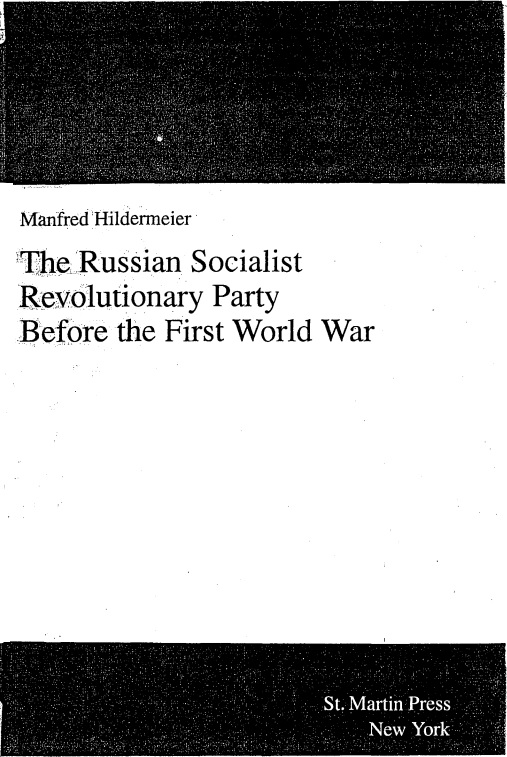Biblioteca / 2000-2009
Manfred Hildermeier. The Russian Socialist Revolutionary Party Before the First World War.
Münster/New York: Lit Verlag/St. Martin’s Press, 2000.
395 páginas.
CONTENTS
Preface to the English Edition
Introduction
1. The Merger of the Neo-Populists (1893-1901)
Forerunner Organizations Inside Russia
Realignments Among Exile Populists
The Founding of the PSR and the Programmatic Consensus
2. Theory, Program, and Fundamental Forms of Action of the Socialist-Revolutionary Party (1902-1905)
Political Terror
Theory of Class
Theory’of Revolution
The Party Program
Socialization of the Land
Minimal and Maximal Programs
Summary: The “Synthetic Point Of View”
3. The Construction of a Party Organization and the Beginnings of Socialist Revolutionary Agitation in Russia (1902-1905)
Territorial Expansion
The Center in Russia
Priorities of Agitation
Relations between PSR in Russia and the Foreign Organization
4. The Maximalist Heresy (1904-1906)
Agrarian Terrorists
The Moscow Opposition
The Organization, Theory and Dispersion of Maximalism
5. PSR Tactics in the Revolution of 1905-1907: Between Agitation for Revolt and Peaceful Opposition
Militant Agitation
Experiment in Legalism
The Test: SR Agitation and the Missed Revolution in 1906
A Failed Putsch: SR Agitation in the Army
Principled Boycott: The PSR Position on the State Duma
“Fighting Tactics” Instead of Trade Unionism: SR Agitation Among the Workers
6. The SR Party Organization in the Revolution of 1905-1907
The Draft: Central and Local Party Statutes
Construction of the Party Organization
Membership
The Practical Work of the Party Leadership
Centralism vs. Federalism
7. The PSR at the Grassroots: Activities and Organization of Local Committees in the Russian Revolution of 1905-1907
Agitation in the City and Countryside: a Survey
The Volga Area
Ukraine
The Central Industrial Region
Belorussia
South Russia
The Don Region
North Russia
The Urals
Siberia
The Caucasus
The Northern Caucasus Region
The Far East Oblast Union of the PSR
Turkestan
Moscow
Petersburg
Organizational Problems and Internal Conflicts
Membership Strength and Social Geography of the PSR
8. Party Finances
9. The Social Characteristics of the PSR
Generations of the PSR
Education and Social Structure
10. The Dilemma of the Socialist Revolutionary Organization
11. The Agony of the Socialist Revolutionary Organization (1907-1914)
12. The Crisis of the PSR: Differences of Opinion over the Lessons of the Revolution and the Formation of Factions
The Immobility of the Party Center
New Opposition: Neo-Maximalists and Liquidators
Party Split: Legal Socialist Revolutionaries
New Forms of Social Action and the Crisis of the Socialist Revolutionaries’ Revolutionary Agitation
Individual Terror: Anachronistic Politics
Decay of the Obshchina and the Crisis of the Socialist Rvolutionary Program
The Missed Connection
13. The PSR and Modernization: Was There a Populist Alternative?
Literature
A. Chronology
B. Short Biographies
